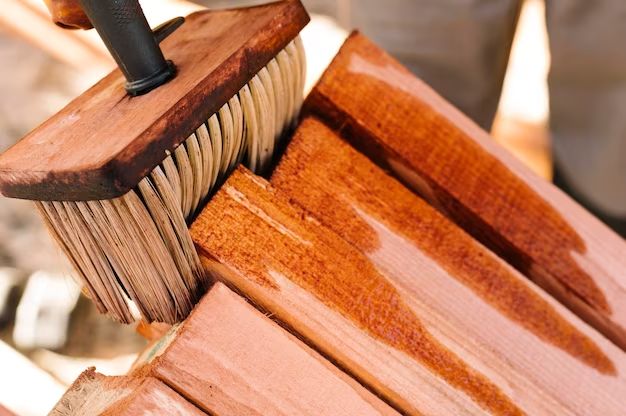Choosing the right type of varnish is crucial for protecting and enhancing the look of a wood table. The varnish creates a protective coating that shields the wood from moisture, spills, scratches and other damage. With so many options on the market, it can be tricky to decide which varnish is best for your particular table.
Page Contents
Key Factors to Consider
When selecting a varnish, there are a few key factors to take into account:
- Type of wood – Soft woods like pine are more porous than hardwoods like oak. The wood type will impact the absorption rate and final look of the varnish.
- Desired finish – Do you want a glossy finish or more of a matte look? Some varnishes deliver more luster than others.
- Durability needs – Consider the wear and tear the table will endure. Higher-traffic dining tables need tougher varnish than an accent table.
- Ease of application – Brush-on varnishes require more skill to apply evenly. Spray or wipe-on options are simpler for DIYers.
- Indoors vs. outdoors – Outdoor tables need specialized varnish that withstands sun, rain and other elements.
Types of Varnish for Wood Tables
With those factors in mind, here is an overview of common varnish types for wood tables:
Polyurethane
Polyurethane varnish is a popular choice for protecting wood tables. It forms a durable, plastic-like coating that strongly adheres to the wood surface. Oil-based polyurethane provides the best moisture resistance. Water-based poly dries faster but is not quite as tough. Polyurethane is available in gloss, satin and matte finishes.
Lacquer
Lacquer varnish dries fast to create a very smooth, durable coating. It comes in high-gloss formulations but can also provide satin finishes. Lacquer sprays on easily for flawless, professional results. It does have a strong odor during application. Lacquer varnish shows off the natural wood grain beautifully.
Shellac
Shellac is a natural varnish made from resin secreted by the lac insect. It dries faster than other varnishes for quick project turnaround. Shellac brings out a subtle, warm wood tone. However, it is not as strong or water-resistant as synthetic varnishes. Shellac is best used for small surfaces on furnishings that will not endure heavy wear.
Spar Varnish
Spar varnish contains UV blockers and is specially formulated to withstand sun, rain, snow and temperature extremes. This makes it ideal for coating outdoor wood tables. The varnish retains its glossy sheen even after months of outdoor exposure. Spar varnish takes longer to dry but delivers superior longevity.
Tung Oil
Tung oil is derived from the nut of the tung tree. When used as a varnish, it penetrates deep into the wood grain to accentuate natural pattern and color. Tung oil dries slowly with a matte to satin sheen. It must be applied in very thin coats. Tung oil protects against water rings, spills and other damage. It is not as durable for high-wear situations.
Prepping Wood Surfaces for Varnish
Proper preparation is crucial for the varnish to adhere well and provide maximum protection:
- Sand the wood thoroughly with fine grit sandpaper to create a smooth surface.
- Wipe away all dust with a tack cloth.
- Fill any holes, scratches or imperfections with wood filler and re-sand once dry.
- Apply a wood conditioner or primer if desired.
Applying Varnish to a Wood Table
These application tips will help you achieve a smooth, even varnish coating:
- Work in a clean, dust-free area to prevent debris getting trapped in the varnish.
- Stir the varnish before and periodically during use.
- Use a high-quality natural bristle brush for the smoothest results.
- Maintain a wet edge and overlap strokes to prevent brush marks.
- Sand lightly between coats using 220+ grit sandpaper.
- Allow proper drying time between coats.
- Apply at least 2-3 thin coats for best durability.
- Consider finishing with paste wax over the varnish for extra protection.
Best Varnish Options for Common Wood Table Types
The optimal varnish choice depends on the specific wood type. Here are top recommendations for some typical table surfaces:
| Wood Type | Best Varnish Options |
|---|---|
| Oak | Polyurethane, Lacquer |
| Maple | Water-based Polyurethane, Lacquer, Shellac |
| Cherry | Lacquer, Tung Oil |
| Walnut | Tung Oil, Polyurethane |
| Pine | Polyurethane, Shellac |
| Teak (Outdoor) | Marine Spar Varnish, Teak Oil |
Frequently Asked Questions
What sheen should I choose?
Gloss varnish has the most lustrous shine but also shows imperfections. Satin is moderately shiny and hides flaws well. Matte varnish has no luster but feels natural. Consider the style of the table and room when choosing sheen.
How long does varnish take to dry?
Drying times range widely based on product, temperature, humidity and ventilation. Oil-based varnishes take 8-24 hours between coats. Water-based options dry in 1-2 hours. Quicker drying lacquer can be recoated after 30-60 minutes.
Does varnish yellow over time?
All film finishes, including varnish, will develop an amber tint over time when exposed to UV light. Water-based varnishes resist yellowing better. Lacquer and shellac also stay color-true longer than oil-based polyurethane.
Can you put polyurethane over lacquer?
Lacquer and polyurethane do not bond well to each other. You cannot apply poly on top of lacquer. However, you can apply lacquer over previously polyurethaned wood.
Should I use matte or gloss varnish?
Gloss varnish makes wood grain pop but shows imperfections. Matte has a smooth, understated look. Satin splits the difference with a soft glow. Choose your sheen based on the style of the table and room décor.
Conclusion
The right varnish strengthens and beautifies a wood table while minimizing risks of damage. Consider the wood type, your desired finish, and other usage factors before selecting a varnish. Proper surface prep and application techniques also help maximize performance. With a little research and care, you can achieve great results and give your wood table a protective finish that lasts for years.
